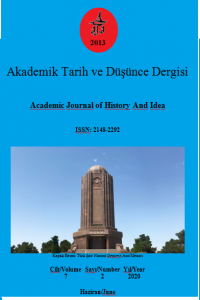К ВОПРОСУ О ГРАММАТИЧЕСКИХ НЕСООТВЕТСТВИЯХ В ИЗУЧЕНИИ РУССКОГО ЯЗЫКА КАК ИНОСТРАННОГО В ТУРЕЦКОЙ АУДИТОРИИ
русский как иностранный, грамматика, интерференция, турецкие учащиеся.
On Grammar interferences in studying russian as a foreign language in the turkish audience
Russian as a foreign language, grammar, interference, Turkish students.,
___
- ALTINBEKOVA O.B. Kategoriya roda russkogo yazıka kak potencialnaya oblast interferenciyi. Russkiy yazık v sovremennom mire: traditsiyi i innovatsiyi v prepodavanii russkogo yazıka kak inostrannogo i v perevode. M., 2009, 12-16.
- DMİTRİYEVA Y.A. Glagolı dvijeniya v tyurkogovorawey auditorii. Russkiy mir i russkoye slovo v mejkulturnom prostranstve. Stambul, 2010, 68-71.
- Doroga v Rossiyu, Uchebnik russkogo yazıka (Elementarnıy uroven). M-SPb., 2003.
- KRILOVA N.G., SOKOLOVA İ.B. Naglyadnıye materialı po russkomu yazıku. Vıp. 1. Znakomstvo. M., 2006.
- MEERMANOVA. J.A. İzucheniye vidov russkogo glagola v turetskoy auditorii. Teoriya i metodika prepodavaniya slavyanskih yazıkov kak inostrannıh. 2009, 345-346.
- NAPOLNOVA E.M. Russkiye glagolı dvijeniya v turetskoy auditorii. Vestnik TsMO MGU, № 3, 2012, 41-44.
- NURİEVA S.G. Suffiksalno-prefiksalnıye sposobı obrazovaniya buduwego vremeni v raznostrukturnıh yazıkah (Na primere russkogo i turetskogo yazıkov). Razvitsiye slovoobrazovatelnoy i leksicheskoy sistemı russkogo yazıka. Materialı VI Mejdunarodnogo nauchnogo seminara, posvyawennogo pamyati professora E.P. Kadkalovoy. Saratov. Amirit. 2016, 201-205.
- PEHLİVANOVA K.İ., LEBEDEVA M.N. Grammatika russkogo yazıka v illustraciyah. M., 1990.
- Yayın Aralığı: Yılda 6 Sayı
- Başlangıç: 2013
- Yayıncı: Hakan YILMAZ
Azerbaycan-Dağıstan-Türkiye ilişkileri açısından Kumuk Hasay Han Usmiyev’in Faaliyeti
Azərbaycan Nağıl Məkanının Təşkilində Toponimlər
Səfəvilər Dövlətində Kənd Təsərrüfatı, Sənətkarlıq və Ticarət (Rocer Seyvorinin Tədqiqatı Əsasında)
Yusuf Akçura’nın Vefatının Türk Basınına Yansımaları
Çal Kültür Tarihi ve Sudan Koyun Atlatma Geleneği
Ahmet SOYSAL, Ümran Ozan KARAHAN
Revan Muhafızı İbrahim Paşa’nın Muhallefatı
Fransız Sömürgeciliğinin Temelleri: “Medenileştirme Misyonu” ve “Asimilasyon Doktrini”
زمینههای خاطره در رمان آتش به اختیار
Mahmood HADDADIAN, Habibullah ABBASİ
Rize’de Yaşanan Aşayiş Sorunuyla İlgili Birer İhbarname ve Layiha Örneği (1909-1911)
